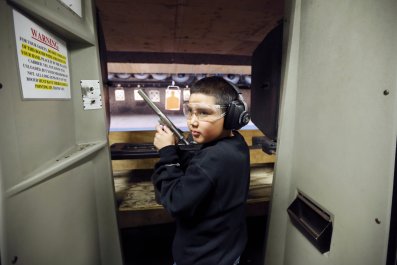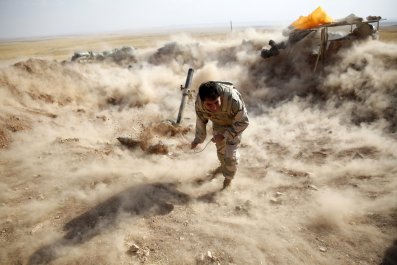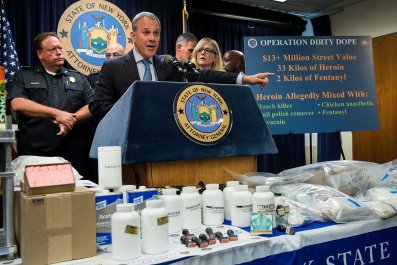In 1998, 15-year-old Kip Kinkel murdered his parents at their home, then killed two students at his Oregon high school. In journal entries he wrote prior to the rampage, he expressed hatred for "every person on this earth." Eric Hainstock, also 15, shot and killed his high school principal in Wisconsin in 2006. In letters from prison, he blamed the principal, his teachers and social services "for never listening to me." And before 16-year-old Alex Hribal stabbed 20 students and a security guard with kitchen knives at his high school in Pennsylvania two years ago, he wrote a letter blaming his actions on teachers and society.
Nearly all experts agree: We need to become more attuned to the subtleties of teenagers' language and behavior if we want to prevent violent acts at schools. Researchers at Cincinnati Children's Hospital Medical Center are taking this idea a step further. In a pilot study, they administered a 28-item questionnaire to students to try to predict who would likely commit a violent act.
That's a useful thing to know, but what should parents and schools do with minors identified as likely to commit a violent act? There is no pill to prevent violence, but the need is great. Between July 2012 and June 2013, there were 53 school-associated violent deaths in elementary and secondary schools in the U.S., according to the National Center for Education Statistics. During the 2013-2014 academic year, 65 percent of public schools had one or more violent incidents, amounting to about 757,000 nationwide. And so often, as in the cases of Kinkel, Hainstock and Hribal, it seems parents or teachers might have prevented the violence if only they had listened better to what the teenagers were saying.
The study was led by Dr. Drew Barzman, director of the Child and Adolescent Forensic Psychiatry Service at Cincinnati Children's. He and his colleagues recruited 25 middle and high school students in Ohio and Kentucky. In a report published in the July issue of Psychiatric Quarterly, the researchers said they considered 11 of the 25 students, or 44 percent, as being at high risk of verbal or physical aggression or violence toward others. Some students had mental health issues, but the team discovered that there was not a 100 percent correlation between a student's mental health and the researchers' determination of his or her risk for violence.
Doctors on the team then applied what's called manual annotation, a method for extracting information from language that would offer clues to the students' behavior. Researchers used the method to identify and categorize key words and phrases from transcripts of the taped student interviews with known risk factors. The analysis showed that the high-risk students spoke more about four specific types of content: violent acts or thoughts, negative feelings or actions of others, self-harm and violent media.
Barzman advised parents and school mental health professionals about what they could do to help students likely most at risk for violent behavior. To avoid labeling individuals at school, he didn't share with counselors whether he considered a student to be at high or low risk for violence.
But identifying a student as at risk doesn't guarantee that he or she will act violently, which is a major ethical concern of the study. How much can you restrict a child's freedom? As Arthur Caplan, director of the Division of Medical Ethics at New York University Langone Medical Center, points out, smoking cigarettes doesn't necessarily mean you will develop lung cancer. Often, a diagnosis comes before a standardized treatment is available, such as with Alzheimer's disease.
"We want to be able to have some risk prediction, but it's one small study on a very tiny sample," Caplan says. "It's going to have to be replicated to treat it responsibly. You're going to have to do it in different ethnic groups, different cultural groups, different populations."
But he also recognizes that Americans hope to curb school violence, especially after high-profile shootings at a school in Newtown, Connecticut, in December 2012, and at another in Townville, South Carolina, in September, to name just two. He credits the pilot study for monitoring speech patterns that might give professionals a better indication of imminent or high risks of violence, and he says churches or Boy Scouts troops, for example, could adopt it on a smaller scale. "It's going to be a long time, although people may still try to use it as a quick fix," Caplan says. "We're so desperate to prevent terrible things...that people will use anything."
The research team's ultimate goal is to develop an algorithm to replace the manual annotation. Then they plan to create a cellphone app to quickly and objectively analyze students' words, determine risk levels and make recommendations to parents and schools.
The study had profound implications for some of the students. After answering Barzman's questions and discussing with him strategies to cope, Madison York, a 13-year-old who experienced bullying throughout middle school in Ohio, told her peers she wouldn't tolerate their name-calling. She tells Newsweek she learned not to "let one person get to you." It sounds simple, but by sharing her experiences with Barzman and applying his suggestions to her situation at school, she gained the courage to speak out against peers who taunted her. Now she says she loves going to school and has a wide support system of friends.
Barzman realizes an app can't pick out warning signs in students' voices or nonverbal cues. The technology won't replace human interaction. Instead, he hopes interviewers around the country will use the app as a complement to the 28-item questionnaire.
Barzman and his team hope to recruit and study at least 300 more students to fully develop the manual annotation algorithm and then the app. Although that's still a small number, it should enable researchers to be more confident about their results and help diversify the app. They anticipate needing additional samples of students from various regions of the country to capture linguistic differences, like slang words or local dialect. They want to eventually offer the test and technology as a standard tool for schools nationwide.
Their test and app won't prevent every act of school violence. But even if it identifies some at-risk kids, that's better than the alternative—not naming any.






















